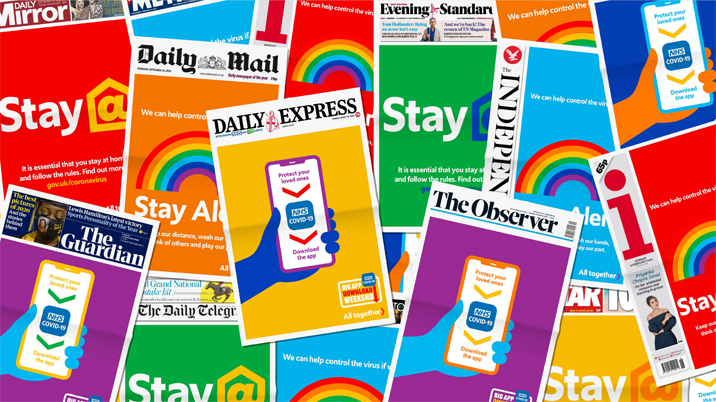
In June, we held a Festival of News at the British Library to bring the dynamism, innovation and frontline nature of journalism to life for an audience of advertisers.
We were lucky enough to have a top line-up of editors, sports writers, campaigners and leading political commentators on stage throughout the day as well as an amazing line up of the next generation of young journalists.
Listening to them all talk about their passion for their craft of journalism and why it matters was mesmerising, uplifting and entertaining. The day drove home just how alive, plural, vibrant and vital journalism is in the UK and those marketers who attended the festival left the day feeling as inspired as I was about the importance of quality trusted journalism.
So, what’s the problem?
On the face of it there shouldn’t be one.
Millions of readers are turning to trusted and established sources of information they know they can rely on – whether that’s the latest information on the invasion of Ukraine, the cost-of-living crisis or the amazing Lionesses winning the Euros.
Over the last ten years, news brand readership has been on the rise. National news brands now reach more people than ever before. According to PAMCo, at the last count, the numbers were 26 million daily, 41 weekly and 47 million monthly readers.
Pretty staggering figures when you think about it and those audience numbers rival if not surpass the UK audience numbers for Facebook and Google.
I would expect these numbers to continue to rise as we see more creativity, innovation and collaboration at individual publishers but also collectively across the industry.
One of our most recent and largest research studies to date, World Without News, explored the role of news brands in today’s contemporary landscape.
It was a vast project spanning over a year’s work from our insights team and our partners – Office of Ideologies, Map the Territory and Tapestry Research – and the highlights of the study revealed how the nation’s appreciation and value of journalism had increased dramatically since the onset of the global coronavirus pandemic.
Some 66% of news consumers said they “appreciated and valued journalism more since the global coronavirus pandemic began”. The increase is most stark in the under 35-year-olds, with 77% valuing the work of journalists more now in providing reliable information and news.
Both the growth in readership and sentiment towards quality trusted journalism in news brands, especially among younger people, is strong.
But what’s disappointing is that advertising spend does not follow that same trajectory of growth.
And, for me, this is the greatest commercial challenge for news brands.
Why is ad spend not mirroring audience growth?
Simply put, because of wrongly held perceptions about our industry being antiquated and complicated when in fact the reality is quite the opposite.
If any new shiny entrant to the market had even half the levels of engagement and readership of news brands, I am sure that the advertising pounds would soon follow that audience growth and attention.
It’s no easy task to overhaul these perceptions but our job at Newsworks, and collectively as an industry, is to challenge and shift that perception among media agencies to show ourselves as innovators, modernisers, pioneers and collaborators.
The community of young media planners across media agencies – who decide just where those advertising pounds are spent – are by far the hardest cohort to crack.
On top of the strong audience numbers, which speak for themselves, we have to work harder to convince them of how easy and effective we are to do business with and why context, content and trust are absolutely key in driving engagement with their clients’ brands.
Why do I think this?
In 2020, as the nation went into lockdown, we came together as an industry in a national crisis to deliver much needed advice, support and guidance to the UK population on behalf of the UK government.
We did this in a way that drove impact and action by humanising government messaging and leveraging reader loyalty and trust in their news brand.
Our ability to work effectively with the Cabinet Office to deliver important information at the pace of a newsroom, in a compassionate tone that readers could relate to, was vital, as was our ability to accommodate unprecedented turnaround times and ever-changing messaging.
Initially the partnership was launched as a three-month campaign, but it was extended, time and time again. In total, the industry delivered 84 content briefs over the two years.
We have shown how we can create bespoke content that resonates with individual readers across 600 news brands, in print, online and across all digital platforms. Importantly, we can do this at speed, at scale and with the agility no other medium can rival.
The metrics we were judged by – recall, trust in the partnership content and behaviour change – all outperformed expectations and exceeded other government communications.
It’s an amazing case study for us and one we are amazingly proud of because it ticks all the boxes of collaboration and creativity. It’s a clear statement of progression, and the levels of trust maintained throughout the campaign is a huge achievement and highlights the loyal relationship between news brands and their readers.
We can now mobilise the entire industry through one point of contact which makes things much easier for agencies and their clients. In a nutshell, we are much simpler to do business with.
Are news brands really that effective for advertisers?
All our stakeholders have developed different business models – including subscriptions, reader support and data-led propositions – but advertising still has an important role to play, because it is highly effective. News brands have massively engaged audiences that are hugely attractive to advertisers.
With the rise of fake news, misinformation and disinformation across other mediums, news brands have seen record numbers of people relying on them for trusted information and analysis.
In 2021, effectiveness expert Peter Field studied 182 advertising campaigns that showed how news brands have a significant impact on key business drivers such as market share, pricing and profit.
This is largely because ads appearing in news brands are increasingly perceived as more trustworthy and high quality by readers, which are now two of the most important factors that lead to growth for advertisers.
This increased demand for trust and quality has had a beneficial knock-on effect for advertisers.
Over the last six years, the impact on trust in brands that advertise on a single news brand platform has more than doubled having risen from 13% in 2014 to 30% in 2020. When the advertising appears across two news brand platforms, the increase is quite phenomenal having risen over six times (9% in 2014 v 56% in 2020).
News brands – and increasingly across their digital platforms – deliver incredibly strong business effects for brands. They are able to do this because of their strong impact on brand trust and quality perceptions – two brand effects that are now most strongly linked to profit growth.
The big opportunity
For me, the big opportunity that lies ahead is in partnerships and more cross-publisher collaboration. As an industry, we have proved that we can work together effectively and that we are much easier to do business with than people think.
The evidence is there that news brands are highly effective for advertisers – the audience and scale is certainly there and so is the collaborative and innovative spirit within the industry. And when it comes to trusted quality content, we are second to none.
There is certainly more active interest out there from advertisers as they understand the importance of supporting quality, trusted journalism and the benefits that they can derive from advertising in these environments. We have to drive the message home more frequently about why journalism matters to their bottom line and how it can help grow their businesses.
The challenge is that we need to convince a much wider audience than those that attended our Festival of News. We need to grab the attention of more advertisers and showcase to them just how future-focused we are as an industry, and how we always have been – and always will be.
If we can do this, then we can close the gap between readership growth and advertising revenues.
This article was first published in InPublishing magazine. If you would like to be added to the free mailing list to receive the magazine, please register here.












